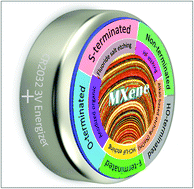A Mini-Review: MXene composites for sodium/potassium-ion batteries
Abstract
MXenes, as a new type of two-dimensional layered structure material, have attracted much attention. MXenes have high electronic conductivity, a large specific area, excellent mechanical properties and a unique layered structure and have been extensively used in energy storage, adsorption, catalysis and other fields. In recent years, Mxenes and their composite materials have been widely used in the field of secondary batteries. Although oxides, sulfides and other materials have high capacity, there are problems such as low conductivity, volume expansion in the reaction process, poor cycling stability, etc. Therefore, building composite materials with MXenes can not only improve the capacity but also enhance the electronic conductivity of the materials, effectively alleviate volume expansion in the reaction process, and achieve better electrochemical performance. This article reviews the latest research status of MXenes, the synthesis methods, properties and application of MXenes and their composite materials in sodium-ion batteries (SIBs) and potassium-ion batteries (PIBs), briefly introduces the research background of SIBs, PIBs and MXenes, and focuses on the application research of MXene composite materials in SIBs and PIBs, including classification according to sulfide, oxide and carbon materials. Finally, the development and application prospects of MXenes and their composite materials are summarized.

- This article is part of the themed collection: Recent Review Articles


 Please wait while we load your content...
Please wait while we load your content...